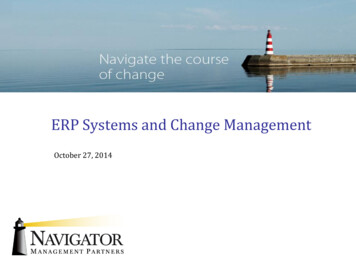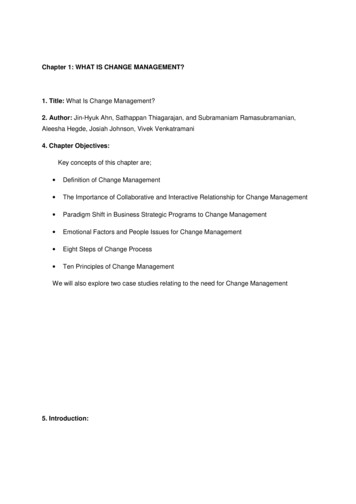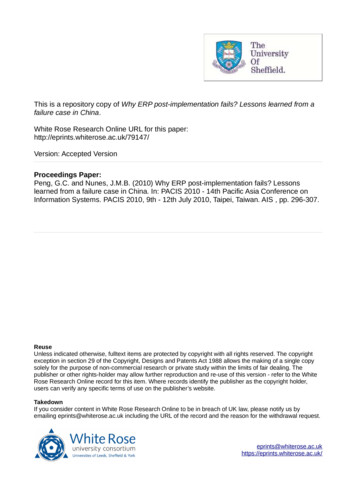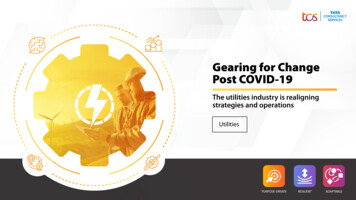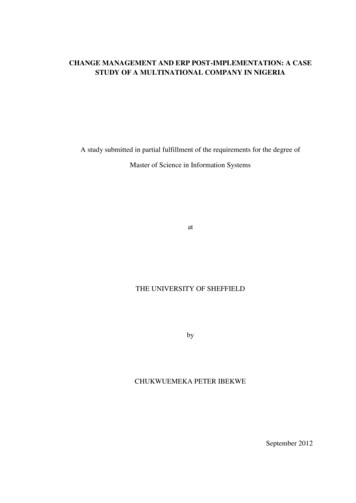
Transcription
CHANGE MANAGEMENT AND ERP POST-IMPLEMENTATION: A CASESTUDY OF A MULTINATIONAL COMPANY IN NIGERIAA study submitted in partial fulfillment of the requirements for the degree ofMaster of Science in Information SystemsatTHE UNIVERSITY OF SHEFFIELDbyCHUKWUEMEKA PETER IBEKWESeptember 2012
ABSTRACTBackground. Enterprise Resource Planning (ERP) systems are business applicationswhich organizations utilize to integrate their business processes and improve theirbusiness performance. In the post-implementation stage of ERP life cycle,organisations seek to maximize their benefits from ERP. During this period,organisations initially experience a drop in performance levels. As a result, severalbusiness process, technological and human changes are implemented in order toreturn to normal performance levels and improve their business operations.Aims. The study aimed to investigate the business process, technological and humanchanges implemented during ERP post-implementation in a multinational company,and the barriers to the implementation of these changes.Methods: The study used an inductive research approach and qualitative researchstrategy. Using the case study strategy, six in-depth semi-structured interviews wereconducted with experienced and knowledgeable employees of a multinationalcompany in Nigeria. The data was analyzed using narrative analysis.Findings. The results of the study indicated that business processes includinginvoice management processes, authorization and approval processes and partneraccounting processes had experienced changes during ERP post-implementation.The addition of add-ons and new modules were the technological changesexperienced in the organisation. With regards to the human changes, an organisationwide functional support structure and ERP module-specific roles were integratedwithin the organisation’s structure in the post-implementation stage. Barriers to theimplementation of these changes included: lack of change readiness, internal policiesand procedures, and budgetary constraints.Conclusion. It is concluded that the findings of this study corroborated the outcomesof previous studies which suggested that several business process, technological andhuman changes are implemented during ERP post-implementation, each of whichcan be impacted by several barriers. It is recommended that further work couldinclude the validation and generalization of the findings of this study, and theprioritization of the barriers identified in this study.ii
ACKNOWLEDGEMENTI wish to appreciate Mr Alex GC Peng for his valued support throughout the periodof undergoing this project. I also wish to express my gratitude to my parents Mr andMrs Ibekwe for the rendering all the support they could possibly muster. Also, I wishto thank Mr Shaibu Ali for his assistance in securing participants for the study.iii
TABLE OF CONTENTSABSTRACT .iiACKNOWLEDGEMENT . iiiLIST OF FIGURES . 8LIST OF TABLES . 81.2.INTRODUCTION . 91.1RESEARCH BACKGROUND . 91.2STATEMENT OF THE PROBLEM . 91.3RESEARCH QUESTIONS . 101.4AIMS AND OBJECTIVES . 101.5SIGNIFICANCE OF THE STUDY . 111.6ORGANISATION OF STUDY . 11LITERATURE REVIEW . 132.1INTRODUCTION . 132.2THE CONCEPT OF ERP SYSTEMS. 132.3ERP HISTORICAL BACKGROUND . 152.4ERP LIFE CYCLE . 162.5ERP POST-IMPLEMENTATION . 182.6CHANGE AND CHANGE MANAGEMENT . 202.7CHANGES TRIGGERED BY ERP POST-IMPLEMENTATION . 222.8 CHANGE BARRIERS IN ERP POST-IMPLEMENTATION . 243.2.9ERP IN THE CONTEXT OF NIGERIA . 252.10SUMMARY . 26RESEARCH METHODOLOGY . 273.1INTRODUCTION . 273.2RESEARCH APPROACH . 273.3RESEARCH STRATEGY . 29
3.3.1 CASE STUDY RESEARCH STRATEGY . 303.3.23.44.DATA COLLECTION . 323.4.1INTERVIEW. 323.4.2THE USE OF SEMI-STRUCTURED INTERVIEWING . 323.4.3INTERVIEWEES . 333.4.4INTERVIEW DESIGN . 343.4.5INTERVIEW ADMINISTRATION . 353.5DATA ANALYSIS . 363.5ETHICAL CONSIDERATIONS . 383.6SUMMARY . 38RESEARCH FINDINGS . 394.1INTRODUCTION . 394.2INTERVIEWEE A . 394.2.1BUSINESS PROCESS CHANGES AND CHANGE BARRIERS . 394.2.2TECHNOLOGICAL CHANGE AND CHANGE BARRIERS . 404.2.3HUMAN CHANGE AND CHANGE BARRIERS . 414.2.4CONCLUSIONS . 414.3INTERVIEWEE B . 424.3.1BUSINESS PROCESS CHANGES AND CHANGE BARRIERS . 424.3.2TECHNOLOGICAL CHANGE AND CHANGE BARRIERS . 424.3.3HUMAN CHANGES AND CHANGE BARRIERS . 434.3.4CONCLUSIONS . 434.45CASE COMPANY . 31INTERVIEWEE C . 444.4.1BUSINESS PROCESS CHANGES AND CHANGE BARRIERS . 444.4.2TECHNOLOGICAL CHANGES AND CHANGE BARRIERS . 444.4.3HUMAN CHANGES AND CHANGE BARRIERS . 44
4.4.44.5BUSINESS PROCESS CHANGES AND CHANGE BARRIERS . 454.5.2TECHNOLOGICAL CHANGES AND CHANGE BARRIERS . 454.5.3HUMAN CHANGES AND CHANGE BARRIERS . 454.5.4CONCLUSIONS . 46INTERVIEWEE E . 464.6.1BUSINESS PROCESS CHANGES AND CHANGE BARRIERS . 464.6.2TECHNOLOGICAL CHANGES AND CHANGE BARRIERS . 464.6.3HUMAN CHANGES ANC CHANGE BARRIERS . 474.6.4CONCLUSIONS . 474.76.INTERVIEWEE D . 454.5.14.65.CONCLUSIONS . 44INTERVIEWEE F . 474.7.1BUSINESS PROCESS CHANGES AND CHANGE BARRIERS . 474.7.2TECHNOLOGICAL CHANGES AND CHANGE BARRIERS . 474.7.3HUMAN CHANGES AND CHANGE BARRIERS . 484.7.4CONCLUSIONS . 48DISCUSSION . 495.1INTRODUCTION . 495.2TECHNOLOGICAL CHANGE AND CHANGE BARRIERS . 495.3BUSINESS PROCESS CHANGE AND CHANGE BARRIERS . 515.4HUMAN CHANGE AND CHANGE BARRIERS . 535.5CONCLUSIONS . 55CONCLUSIONS . 566.1IMPLICATIONS . 576.2LIMITATIONS . 576.3RECOMMENDATIONS . 57REFERENCES. 586
APPENDIX I: A SYNTHESIS OF THE TECHNOLOGICAL, BUSINESSPROCESS AND HUMAN CHANGES AND CHANGE BARRIERS IDENTIFIEDIN THE STUDY . 74APPENDIX II: INTERVIEW QUESTIONS . 76APPENDIX III: INTERVIEW TRANSCRIPTS . 78APPENDIX IV: INTRODUCTORY LETTER . 103APPENDIX V: INFORMATION SHEET . 105APPENDIX VI: PARCIPANT CONSENT FORM . 110APPENDIX VII: CONFIRMATION OF ADDRESS . 113APPENDIX VIII: FIRST EMPLOYMENT DESTINATION FOR SCHOOLRECORDS . 115APPENDIX IX: ACCESS TO DISSERTATION . 116APPENDIX X: RESEARCH ETHICS PROPOSAL. 1187
LIST OF FIGURESFigure 2.1: Enterprise Resource Planning modules (Career Bright, 2011) .13Figure 2.2: Performance trend for ERP implementation (Willis and Willis,2002) .22Figure 3.1: A graphic illustration of inductive and deductive researchapproaches (Matthews and Ross, 2010: 37) . 27Figure 3.2: Narrative analysis framework used for the study 37LIST OF TABLESTable 3.1: Table showing job roles and departments of interviewees .834
1.INTRODUCTION1.1RESEARCH BACKGROUNDEnterprise Resource Planning (ERP) systems, the commercial application packageswhich facilitate the integration of transaction-oriented data and business processesacross an organization and its supply chain (Markus and Tanis, 2000), have beenwidely adopted by organizations across many industrial sectors in both advanced andemergent countries (Zhu et al, 2010). The systems provide organisations withoperational, managerial, strategic and IT infrastructural benefits (Shang and Seddon,2004). For many multinational companies, ERP is considered an indispensablesystem which can improve their competitiveness in the increasingly globalizedmarket place (Sheu et al, 2004, Abdinnour-Helm et al, 2003).As a result of this growing globalization, Nigeria has attracted many multinationalcompanies, most of which are large-scale ERP users. With a population of over 150million, Nigeria (GDP 202.5bn) is considered to be the world’s most populousblack nation and a lower middle income nation (World Bank, 2010; Mursu et al,2000). As its crude oil production averages 2.2 million barrels per day, and with oilreserves estimated at 35.3 billion barrels, Nigeria is the tenth most petroleum-richnation in the world and the most affluent country in Africa (Wikipedia, 2012). Thecountry’s projected 5.4% real GDP growth rate and its openness to foreign equitymakes it an attractive market for multinational companies (The Nation, 2012).1.2STATEMENT OF THE PROBLEMPrior studies have empirically demonstrated that change management can be criticalto ERP success in the post-implementation stage. This is because, in this stage,organisations engage in several activities to stabilize and continually improve theirsystems (Markus and Tanis, 2000). However, organisations also initially experiencea drop in performance resulting from unresolved issues from the implementationphase or their efforts in reengineering processes and cleaning-up their data for theirnew environment (Markus and Tannis, 2000; Ross and Vitale, 2000). As a result,several changes are implemented in order to return to normal operations andoptimum performance levels.9
So far, the majority of the existi
CHANGE MANAGEMENT AND ERP POST-IMPLEMENTATION: A CASE STUDY OF A MULTINATIONAL COMPANY IN NIGERIA A study submitted in partial fulfillment of the requirements for the degree of Master of Science in Information Systems at THE UNIVERSITY OF SHEFFIELD by CHUKWUEMEKA PETER IBEKWE September 2012 . ii ABSTRACT Background. Enterprise Resource Planning (ERP


